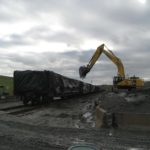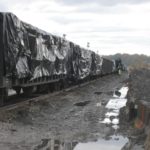The Maywood Chemical Superfund Site is located in Maywood, NJ, about 10 miles west of New York City. From 1916 through 1955, the Maywood Chemical Works processed radioactive thorium ore on site, which resulted in residual radioactive thorium waste. Other processing activities generated various types of chemical wastes. These waste materials were used as fill on site and at nearby properties, resulting in chemical and radioactive contamination over much of the local area.
In the 1960’s, the site was listed under the Superfund program. Later in the 1980’s, when radioactive contamination was found, the site was also listed under the Department of Energy’s FUSRAP program.
The US Army Corps of Engineers (USACE) oversees the on-going remediation work at the site.
Most of the contamination is below ground so the contaminated areas are excavated and the soil is placed in pits to be loaded into lined, rail gondola cars for transport to disposal cells in Utah or Washington.
To control and absorb any free liquid water from the soil, bags of Waste Lock® polymer are added. Before loading begins, a soil sample is tested via EPA 9095 (Paint Filter Test). Depending on the amount of free liquid determined, anywhere from 3 to 6 bags (50 lbs each) of Waste Lock® are added to the bottom and the top of the rail car. Adding absorbent to the top of the load is crucial as vibration during transport causes the soil to compress and squeeze free liquid water to the top of the load. The dry Waste Lock® on the top of the load rapidly absorbs any released liquid.
The top of the rail car is tightly closed with a tarp and shipment begins.
Contact us today to find out which M2 Polymer Technologies polymer solution is best for your application.

